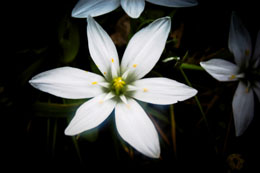The Star of Bethlehem derives its name from the star that led the wise men to the birth place of Jesus. Though beautiful, this flowering plant is considered a nuisance, owing to its trait of encroaching onto other plants and putting them to death.

The Star of Bethlehem is a perennial plant native to the Mediterranean region. It is found in abundance in parts of southern Europe and Africa. The plant derives its common name from its star-shaped flowers, which resemble the Star of Bethlehem mentioned in the Bible. The botanical name for this genus is
Ornithogalum. In the United States, this plant is grown in flowerbeds. It grows best in USDA zone 4 to 11.
Star of Bethlehem
It belongs to the lily family, which grows from a bulb, and is typically characterized by its star-shaped flowers, basal leaves resembling grass, and a slender stalk. The flowers of this plant grow in clusters measuring 30 cm. Bees play the most prominent role in pollination of these plants. Some of the most popular members of this genus include ...
- Star of Bethlehem (Ornithogalum arabicum)
- Common Star-of-Bethlehem (Ornithogalum umbellatum)
- Drooping Star-of-Bethlehem (Ornithogalum nutans)
- Spiked Star-of-Bethlehem (Ornithogalum pyrenaicum)
- Pyramidal Star-of-Bethlehem Ornithogalum narbonense)
How to Grow this Species?
It is one of those species which are grown from their bulbs. You should ideally plant this species 7 to 15 cm deep in well-drained soil and 10 to 15 cm away from each other. If you are growing this plant from the seeds, it is ideal to sow them in flats, cover them with a plastic bag, and keep them in the fridge for a period of 3 weeks before planting them in a shady area. After the plants start cropping up, you can transplant them to an area with more sunlight. The plant tends to take more time to start flowering when grown from the seed, so people prefer to grow it from bulbs.
If you want the plant to flower in summer, you should ideally plant it in spring, and if you want it to flower in spring, you should ideally plant it is autumn. It requires abundant sunlight, and therefore, it should be planted in an area wherein this requirement is fulfilled. Though the plant will grow in slightly shady areas, it will grow slowly and the flower harvest will be quite low. It requires a good drainage system, as over watering can damage its roots. The growth of this plant occurs in spring and by mid-summer the foliage withers away.
Interestingly enough, some of the species of this genus are poisonous in nature, such that grazing animals and pets can die if they feed on them. The Star of Bethlehem is also known for its aggressive growth, which can become a nuisance when left unattended. More importantly, their leaves are resistant to herbicides, which makes it difficult to curb the incessant growth of the species. The good part though, is that you can grow them in flower pots as well, so you don't have to worry about the species affecting other plants in your garden or grazing animals in the neighborhood.






 The Star of Bethlehem is a perennial plant native to the Mediterranean region. It is found in abundance in parts of southern Europe and Africa. The plant derives its common name from its star-shaped flowers, which resemble the Star of Bethlehem mentioned in the Bible. The botanical name for this genus is Ornithogalum. In the United States, this plant is grown in flowerbeds. It grows best in USDA zone 4 to 11.
The Star of Bethlehem is a perennial plant native to the Mediterranean region. It is found in abundance in parts of southern Europe and Africa. The plant derives its common name from its star-shaped flowers, which resemble the Star of Bethlehem mentioned in the Bible. The botanical name for this genus is Ornithogalum. In the United States, this plant is grown in flowerbeds. It grows best in USDA zone 4 to 11.